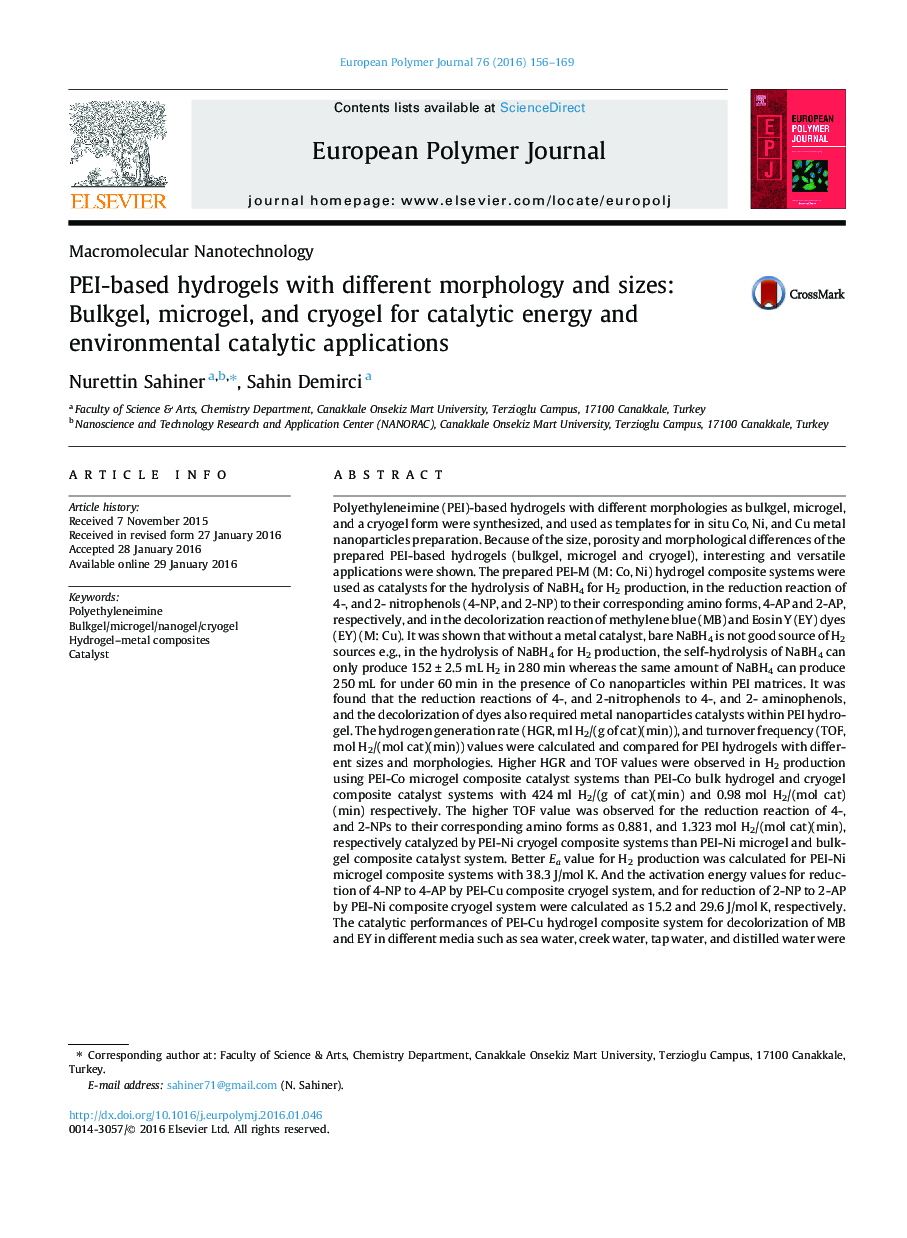| Article ID | Journal | Published Year | Pages | File Type |
|---|---|---|---|---|
| 1401501 | European Polymer Journal | 2016 | 14 Pages |
•Tunable morphological templates of PEI hydrogel as bulkgel, microgel and cryogel.•Versatile sizes of PEI network for in situ metal nanocatalyst preparation.•Superior PEI-M (M:Co, Ni, Cu) catalytic composites for green energy and environmental use.•Fast H2 production, superb nitrocompound reduction and dye decolorization by PEI-M.
Polyethyleneimine (PEI)-based hydrogels with different morphologies as bulkgel, microgel, and a cryogel form were synthesized, and used as templates for in situ Co, Ni, and Cu metal nanoparticles preparation. Because of the size, porosity and morphological differences of the prepared PEI-based hydrogels (bulkgel, microgel and cryogel), interesting and versatile applications were shown. The prepared PEI-M (M: Co, Ni) hydrogel composite systems were used as catalysts for the hydrolysis of NaBH4 for H2 production, in the reduction reaction of 4-, and 2- nitrophenols (4-NP, and 2-NP) to their corresponding amino forms, 4-AP and 2-AP, respectively, and in the decolorization reaction of methylene blue (MB) and Eosin Y (EY) dyes (EY) (M: Cu). It was shown that without a metal catalyst, bare NaBH4 is not good source of H2 sources e.g., in the hydrolysis of NaBH4 for H2 production, the self-hydrolysis of NaBH4 can only produce 152 ± 2.5 mL H2 in 280 min whereas the same amount of NaBH4 can produce 250 mL for under 60 min in the presence of Co nanoparticles within PEI matrices. It was found that the reduction reactions of 4-, and 2-nitrophenols to 4-, and 2- aminophenols, and the decolorization of dyes also required metal nanoparticles catalysts within PEI hydrogel. The hydrogen generation rate (HGR, ml H2/(g of cat)(min)), and turnover frequency (TOF, mol H2/(mol cat)(min)) values were calculated and compared for PEI hydrogels with different sizes and morphologies. Higher HGR and TOF values were observed in H2 production using PEI-Co microgel composite catalyst systems than PEI-Co bulk hydrogel and cryogel composite catalyst systems with 424 ml H2/(g of cat)(min) and 0.98 mol H2/(mol cat)(min) respectively. The higher TOF value was observed for the reduction reaction of 4-, and 2-NPs to their corresponding amino forms as 0.881, and 1.323 mol H2/(mol cat)(min), respectively catalyzed by PEI-Ni cryogel composite systems than PEI-Ni microgel and bulkgel composite catalyst system. Better Ea value for H2 production was calculated for PEI-Ni microgel composite systems with 38.3 J/mol K. And the activation energy values for reduction of 4-NP to 4-AP by PEI-Cu composite cryogel system, and for reduction of 2-NP to 2-AP by PEI-Ni composite cryogel system were calculated as 15.2 and 29.6 J/mol K, respectively. The catalytic performances of PEI-Cu hydrogel composite system for decolorization of MB and EY in different media such as sea water, creek water, tap water, and distilled water were compared and the PEI-Cu cryogel composite provided the fastest decolorization capabilities for both dyes. Interestingly, amongst all the media, MB and EY decolorization in seawater by PEI-Cu cryogel was accomplished in 2 and 9 min with 96.3% and 97.3% decolorization, respectively, with the same catalyst system.
Graphical abstractFigure optionsDownload full-size imageDownload as PowerPoint slide
